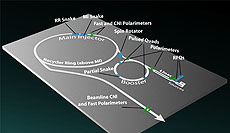Probing the (not so) familiar proton at Fermilab
 |
The proposed polarized proton program at Fermilab aims to answer fundamental questions about the proton and the universe.
|
Among the particle zoo's numerous denizens, the proton, along with the electron, is the closest to being a household name. And yet, a century after its discovery, the familiar proton has managed to keep some fundamental facts about itself extremely close to the vest.
Researchers are currently proposing experiments based at Fermilab to pry this information from the not-so-well-understood particle. Using an intense beam of polarized protons to probe a stationary proton, they hope to uncover some of what makes it tick—and to get answers to longstanding questions about our universe.
One proposed experiment is to measure a proton property called the electric dipole moment, or EDM, which is shorthand for the spatial separation between a negative and positive charge along the spin direction of a particle. The proton EDM has never been measured to be more than zero, but experiment could reveal that it is instead extremely tiny—equivalent to a positive and negative unit charge separated by a distance on the order of 10 trillion trillion times smaller than the width of a human hair.
"I was once asked, 'Can we make an experiment directly sensitive to the EDM?'" said Brookhaven National Laboratory's Yannis Semertzidis, who is leading the proton EDM measurement effort. "That was in 1996. This question has haunted me since."
Researchers could measure the proton EDM directly using a polarized proton beam—a beam of protons whose spins are all aligned—at the right energy. If it uncovered an EDM, it would bring scientists closer to settling an enormous discrepancy: the difference between the amount of matter scientists measure in the universe and what they calculate it should be, which is off by a factor of a billion.
That isn't the only discrepancy researchers could tackle. Another is related to where the spin of the proton comes from. The proton has a spin of ½, but the spins of the proton's constituent quarks and gluons together fall short of that number. So far, scientists haven't been able to experimentally account for the remainder.
Using a polarized beam, researchers would minutely study the spins and momenta of the proton's component parts, perhaps finally reconciling, after decades of investigation, the proton-spin bookkeeping.
"It's like doing 100 years later what people did with the hydrogen atom—but inside the proton," said University of Michigan's Christine Aidala, chair of the polarized-proton workshop organizing committee.
Although the Fermilab accelerator complex does not currently have a way to deliver polarized beams, its beam intensities are practically unrivaled in the world, making it an attractive place to conduct these studies.
"Our advantage over other labs is intensity, and that's just with what we have now," said Argonne National Laboratory's Paul Reimer, who also works on Fermilab's SeaQuest experiment.
Working with Brookhaven—the only laboratory in the United States that can deliver polarized proton beams—a group called Spin at Fermi is researching ways to polarize some of Fermilab's beam.
Scientists involved in the programs are now working to obtain funding for the projects. They hope the particle physics community can get behind the proposals and the search for new physics deep inside the proton.
"Once you get hooked on it, you can't let go," Semertzidis said. "The physics reach is just phenomenal."
—Leah Hesla
|